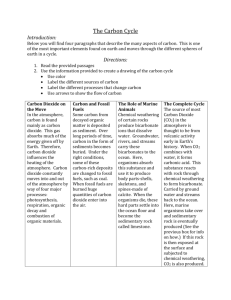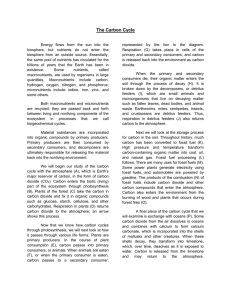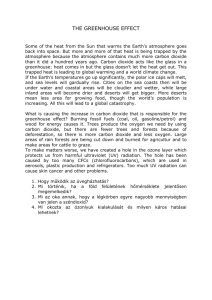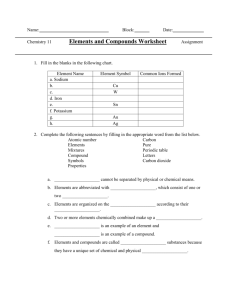Environmental Science Chapter 5 – How Ecosystem Works Section
advertisement
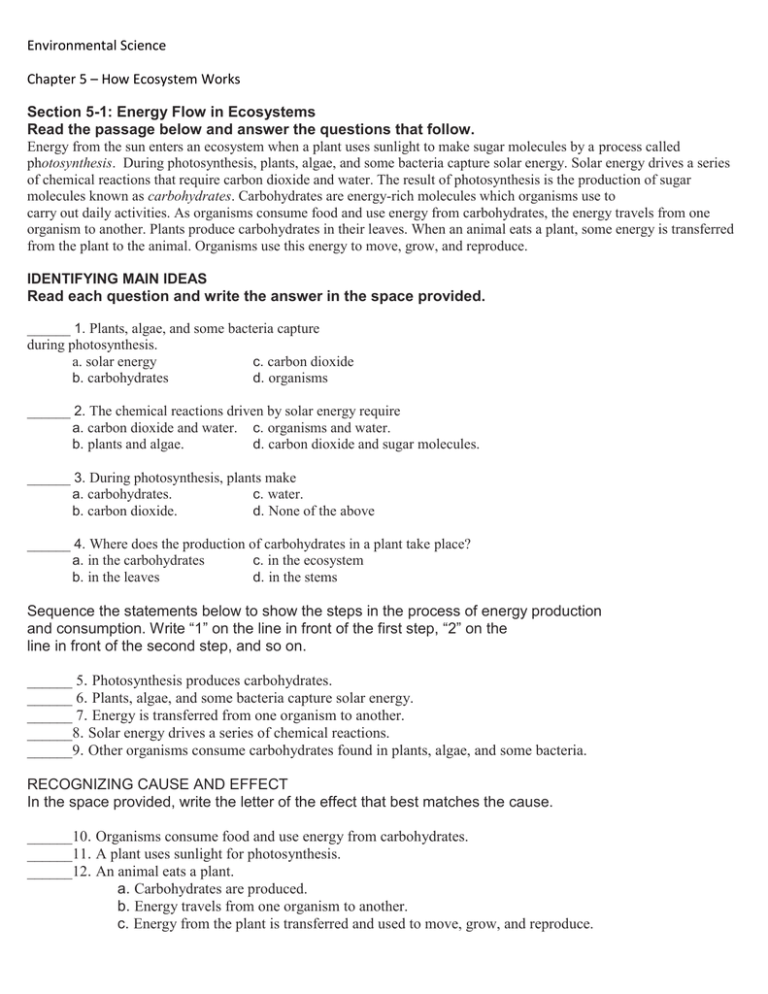
Environmental Science Chapter 5 – How Ecosystem Works Section 5-1: Energy Flow in Ecosystems Read the passage below and answer the questions that follow. Energy from the sun enters an ecosystem when a plant uses sunlight to make sugar molecules by a process called photosynthesis. During photosynthesis, plants, algae, and some bacteria capture solar energy. Solar energy drives a series of chemical reactions that require carbon dioxide and water. The result of photosynthesis is the production of sugar molecules known as carbohydrates. Carbohydrates are energy-rich molecules which organisms use to carry out daily activities. As organisms consume food and use energy from carbohydrates, the energy travels from one organism to another. Plants produce carbohydrates in their leaves. When an animal eats a plant, some energy is transferred from the plant to the animal. Organisms use this energy to move, grow, and reproduce. IDENTIFYING MAIN IDEAS Read each question and write the answer in the space provided. ______ 1. Plants, algae, and some bacteria capture during photosynthesis. a. solar energy c. carbon dioxide b. carbohydrates d. organisms ______ 2. The chemical reactions driven by solar energy require a. carbon dioxide and water. c. organisms and water. b. plants and algae. d. carbon dioxide and sugar molecules. ______ 3. During photosynthesis, plants make a. carbohydrates. c. water. b. carbon dioxide. d. None of the above ______ 4. Where does the production of carbohydrates in a plant take place? a. in the carbohydrates c. in the ecosystem b. in the leaves d. in the stems Sequence the statements below to show the steps in the process of energy production and consumption. Write “1” on the line in front of the first step, “2” on the line in front of the second step, and so on. ______ 5. Photosynthesis produces carbohydrates. ______ 6. Plants, algae, and some bacteria capture solar energy. ______ 7. Energy is transferred from one organism to another. ______8. Solar energy drives a series of chemical reactions. ______9. Other organisms consume carbohydrates found in plants, algae, and some bacteria. RECOGNIZING CAUSE AND EFFECT In the space provided, write the letter of the effect that best matches the cause. ______10. Organisms consume food and use energy from carbohydrates. ______11. A plant uses sunlight for photosynthesis. ______12. An animal eats a plant. a. Carbohydrates are produced. b. Energy travels from one organism to another. c. Energy from the plant is transferred and used to move, grow, and reproduce. Section 5.2: The Cycling of Materials Read the passage below and answer the questions that follow. When we burn fossil fuels, we release carbon into the atmosphere. The carbon returns to the atmosphere as carbon dioxide. Cars, factories, and power plants rely on these fossil fuels to operate. In the year 2000, vehicles were the source of one-third of all carbon dioxide emitted in the United States. All together, about 6 billion metric tons of carbon a year are released into the atmosphere as carbon dioxide. Natural burning of wood or forest fires combined with the burning of fossil fuels make up this 6 billion metric tons. About half of this carbon dioxide remains in the atmosphere, so over a period of years, the amount of carbon dioxide in the atmosphere has steadily increased. Increased levels of carbon dioxide may contribute to global warming, which is an overall increase in the temperature of the Earth. What happens to the carbon dioxide that is not absorbed by the atmosphere? Scientists estimate that over a billion metric tons of carbon dioxide dissolves into the ocean, which is a carbon sink. Plants probably absorb the remaining carbon dioxide. IDENTIFYING MAIN IDEAS Read each question and write the answer in the space provided. 1. What do most cars, factories, and power plants rely on to operate? 2. In what form does carbon return to the atmosphere after it is released from the burning of fossil fuels? 3. One-third of the United States’ carbon consumption is used to operate what? 4. How many tons of carbon are released into Earth’s atmosphere every year? 5. Why does the author mention the United States in the fourth sentence? In the space provided, write the letter of the term or phrase that best completes each statement or best answers each question. ______ 6. Global warming a. is carbon dioxide that dissolves into the ocean. b. is an overall increase in the temperature of Earth. c. is caused by natural burning of wood and forest fires. d. makes up half of Earth’s atmosphere. ______ 7. Which of the following statements is true about fossil fuels, carbon, and carbon dioxide? a. Carbon dioxide returns to the atmosphere as carbon when fossil fuels are burned. b. Fossil fuels return to the atmosphere as carbon dioxide when carbon is burned. c. Carbon returns to the atmosphere as carbon dioxide when fossil fuels are burned. d. none of the above RECOGNIZING CAUSE AND EFFECT Read each question and write the answer in the space provided. 8. What three things cause carbon to be released into the atmosphere as carbon dioxide? 9. What is one effect of increased levels of carbon dioxide in the atmosphere? Section 5.3: How Ecosystems Change Read the passage below and answer the questions that follow. Another example of secondary succession is old-field succession, which occurs when farmland is abandoned. When a farmer stops cultivating a field, grasses and weeds quickly grow and cover the abandoned land. The pioneer grasses and weeds grow rapidly and produce many seeds to cover large areas. Then, over time, taller plants such as perennial grasses grow in the area. These plants shade the ground, which keeps light from the shorter pioneer plants. The long roots of the taller plants also absorb most of the water in the soil and deprive the pioneer plants of adequate water to survive. The pioneer plants soon die from lack of sunlight and water. As succession continues, the taller plants are deprived of light and water by growing trees. Finally, slower-growing trees such as oaks, hickories, beeches, and maples take over the area and block out the sunlight to the smaller trees. After about a century, the land can return to the climax community that existed before the farmers cleared it to plant crops . IDENTIFYING MAIN IDEAS Read each question and write the answer in the space provided. 1. What type of succession is old-field succession? 2. Summarize what happens to a field when a farmer stops cultivating it. 3. What key terms are used in this passage? 4. Define the terms you identified in the previous question. SEQUENCING INFORMATION One reading skill is the ability to sequence information, or to logically place items or events in the order in which they occur. Sequence the statements below to show the steps in old-field succession. Write “1” on the line in front of the first step, “2” on the line in front of the second step, and so on. ______ 5. Taller plants grow in the area and shade the ground. ______ 6. A climax community exists. ______ 7. Pioneer grasses and weeds grow and produce many seeds. ______ 8. A farmer stops cultivating a field. ______ 9. Trees grow and shade the taller plants. ______10. The taller plants die. ______11. The pioneer plants die. ______12. Slower-growing trees shade the smaller trees. Read each question and write the answer in the space provided. 13. What causes pioneer grasses and weeds that have grown in an abandoned field to die? 14. What happens after a farmer abandons a field and the stages of old-field succession take place?



